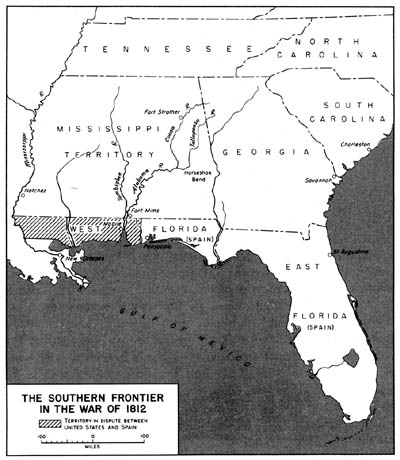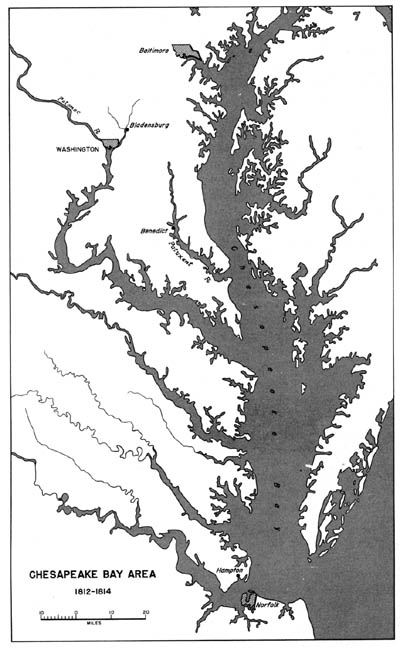Culpeppers in the
War of 1812
The so-called War of 1812 actually spanned several years,
with skirmishes starting as early as 1807 and not ending until 1815. But in
so far as involvement by Culpeppers is concerned, most were
not involved until 1813 when a new theater of operations opened in the south.
The narrative that follows was taken from a much larger work on the
War of 1812,
published by the Center for Military History. We have included descriptions
of only those campaigns that probably involved Culpeppers.
Mississippi Territory (Alabama)
Andrew Jackson, an ardent expansionist and commander of
the Tennessee militia, wrote the Secretary of War that he would "rejoice at
the opportunity of placing the American eagle on the ramparts of Mobile,
Pensacola, and Fort St. Augustine." (Map 17) For this purpose
Tennessee had raised a force of 2,000 men to be under
Jackson's command. Congress, after much debate, approved only an
expedition into that part of the gulf coast in dispute between the United
States and Spain, and refused to entrust the venture to the Tennesseans.
Just before he went north to take part in the Montreal expedition, General
Wilkinson led his Regulars into the disputed part of West Florida and,
without meeting any resistance, occupied Mobile, while the Tennessee army
was left cooling its heels in Natchez.

Map 17
An Indian uprising in that part of the Mississippi
Territory soon to become Alabama saved General Jackson's military career.
Inspired by Tecumseh's earlier successes, the Creek Indians took to the
warpath in the summer of 1813 with a series of outrages culminating in the
massacre of more than 500 men, women, and children at Fort Mims (Baldwin
County, Alabama, north of Mobile). Jackson, with characteristic energy,
reassembled his army, which had been dismissed after Congress rejected its
services for an attack on Florida, and moved into the Mississippi Territory.
His own energy added to his problems, for he completely outran his primitive
supply system and dangerously extended his line of communications. The
hardships of the campaign and one near defeat at the hands of the Indians
destroyed any enthusiasm the militia might have had for continuing in
service. Jackson was compelled to entrench at Fort Strother on the Coosa
River (Calhoun County, Alabama), and remain there for several months
until the arrival of a regiment of the Regular Army gave him the means to
deal with the mutinous militia. At the end of March 1814 he decided that he
had sufficient strength for a decisive blow against the Indians, who had
gathered a force of about 900 warriors and many women and children in a
fortified camp at the Horseshoe Bend of the Tallapoosa River (Tallapoosa
County, Alabama). Jackson had about 2,000 militia and volunteers, nearly 600
Regulars, several hundred friendly Indians, and a few pieces of artillery.
The attack was completely successful. A bayonet charge led by the Regulars
routed the Indians, who were ruthlessly hunted down and all but a hundred or
so of the warriors were killed. "I lament that two or three women and
children were killed by accident," Jackson later reported. The remaining
hostile tribes fled into Spanish territory. As one result of the campaign
Jackson was appointed a major general in the Regular Army.
Presumably, the Culpeppers in the militias of Georgia and Mississippi, and
possibly South Carolina, were involved in these conflicts:
Virginia and Maryland
Fighting also broke out during 1813 along the east coast
where a British fleet blockaded the Delaware and Chesapeake Bays, bottling
up the American frigates Constellation at Norfolk and Adams in
the Potomac. (Map 18) Opposed only by small American gunboats, the
British under Admiral Sir John Warren sought "to chastise the Americans into
submission," and at the same time to relieve the pressure on Prevost's
forces in Canada. With a flotilla, which at times numbered fifteen ships,
Rear Adm. Sir George Cockburn, Warren's second-in-command, roamed the
Chesapeake during the spring of 1813, burning and looting the prosperous
countryside. Reinforced in June by 2,600 Regulars, Warren decided to attack
Norfolk, its navy yard and the anchored Constellation providing the
tempting targets. Norfolk's defenses rested chiefly on Craney Island, which
guarded the narrow channel of the Elizabeth River. The island had a 7-gun
fortification and was manned by 580 Regulars and militia in addition to 150
sailors and marines from the Constellation. The British planned to
land an 800-man force on the mainland and, when low tide permitted, march
onto the island in a flanking movement. As the tide rose, another 500 men
would be rowed across the shoals for a frontal assault. On June 22 the
landing party debarked four miles northwest of the island, but the flanking
move was countered by the highly accurate marksmanship of the
Constellation's gunners and was forced to pull back. The frontal assault
also suffered from well-directed American fire, which sank three barges and
threw the rest into confusion. After taking 81 casualties, the British
sailed off in disorder. The defenders counted no casualties.

Map 18
Frustrated at Norfolk, Warren crossed the Roads to Hampton
where he overwhelmed the 450 militia defenders and pillaged the town. A
portion of the fleet remained in the bay for the rest of the year,
blockading and marauding, but the operation was not an unalloyed success. It
failed to cause a diversion of American troops from the northern border and,
by strengthening popular resentment (Cockburn was vilified throughout the
country), helped unite Americans behind the war effort.
Presumably, the Culpeppers in the militias of Maryland, Virginia and
possibly North Carolina were involved in these conflicts:
New Orleans: The Final Battle
In late 1814 and early 1815, the Battle of New Orleans
occurred. However, less than 4,000 US troops were involved, and it appears
that they probably were not from any Militias that the Culpeppers were in.
Last Revised:
02 Jan 2015 |